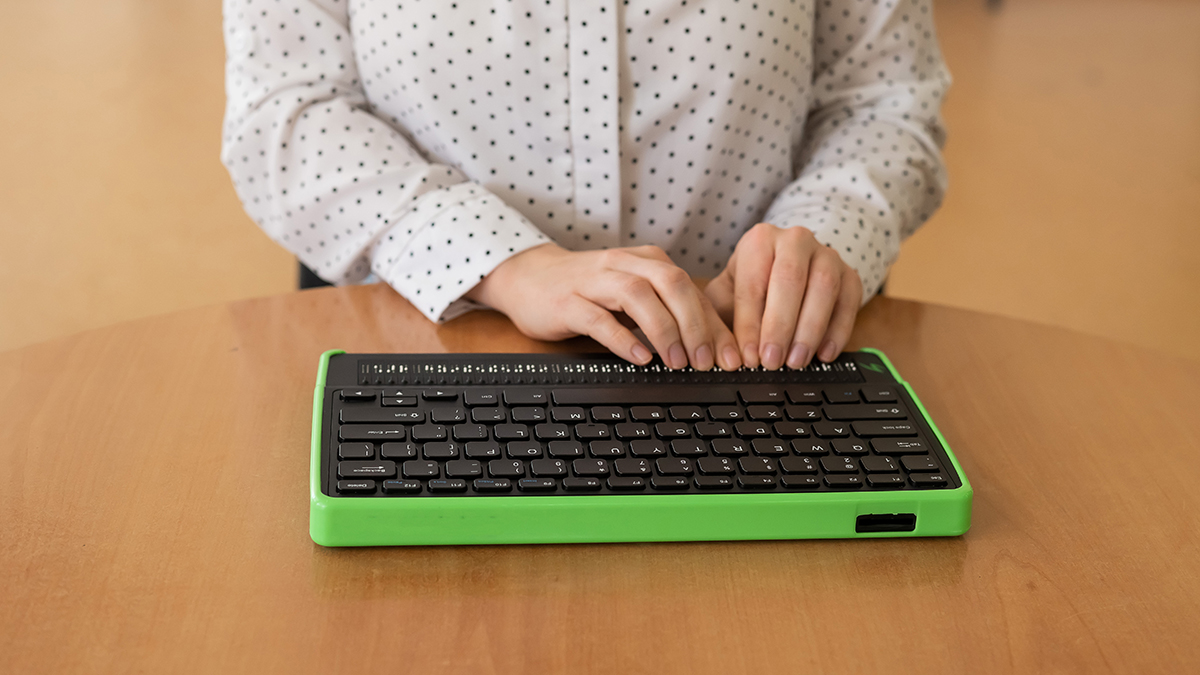feature
Accomodating Visually Impaired Students in Secondary Science
Several years ago, the lead author of this article was informed that she would have a completely blind student in her 10th-grade biology class. She immediately felt alarmed and overwhelmed as biology is a highly visual subject routinely making use of microscopes, triple-beam balances, Bunsen burners, chemicals, dissections, and more, and she was not sure how she would or could modify the labs so that Jenny (pseudonym) could fully participate in all aspects of her class. During that school year, she set in motion a series of accommodations and adaptations that indeed allowed Jenny to fully participate in all labs and other class activities and ultimately earn an A in the course. As a university professor, the author now teaches these methods to her secondary science education students, adding to and modifying strategies and equipment as new technology and ideas emerge.
The Individuals with Disabilities Education Act (IDEA) (2004) defines visual impairment (VI) as blindness or limited vision that, even with correction, impacts the educational performance of a child. The definition refers to both partially sighted and complete blindness. Students with VI can also qualify for accommodations under Section 504 of the Rehabilitation Act of 1973. However, Section 504 provides limited supports since funding is not provided. Many students with VI are covered under IDEA because funding is provided through federal legislation (Wright and Wright 2008). Regardless of disability, students must have access to the general education curriculum, and providing access to students with VI in science can be a challenge. This article will discuss some practical ways to accommodate students with VI in the science classroom.
Background
The Next Generation Science Standards (NGSS) stress the need for ALL students to receive excellent science instruction—including those with disabilities—based upon disciplinary core ideas, crosscutting concepts, and science and engineering practices (NGSS Lead States 2013). Further, the NGSS emphasize reducing disparities in student achievement across all groups (Miller and Januszyk 2014). Also central to the NGSS is the notion that science should be taught via inquiry-based methods, a strategy proven effective for all students, but particularly effective for those with visual impairments (Koehler 2017). In addition, for students with vision impairments, accommodations and modified equipment are necessary for their full participation in inquiry-based instruction (Wild and Koehler 2017).
A visual impairment is defined as a condition that decreases vision due to congenital, traumatic, or hereditary causes and includes low-vision (LV) and blindness. Individuals who are completely blind have no vision at all while those with LV have some level of useful vision. The visually impaired condition is further classified into four categories: reduced visual acuity, central visual field loss, peripheral visual field loss, and a combination of two or more categories (Gissera 2022). As of 2019, there were approximately 547,083 (0.75%) children (ages 0–18) with diagnosed severe VIs in the United States while 3% (55,249) of all children were legally blind (U.S. Census Bureau 2022). While the percentage of U.S. children with diagnosed severe VIs is fairly small (approximately 6–7%), all educators must be prepared to teach them and provide the same experiences in their classrooms as those received by fully sighted children. In science courses, this can be a particularly daunting task, as much of science instruction involves visual observations, representations (photographs, diagrams, and models), visual pedagogical strategies, hands-on investigations, and more. Thus, it is not surprising that individuals with vision impairments are underrepresented in advanced science courses and science careers (Supalo, Isaacson, and Lombardi 2014).
Through the provisions of IDEA, students with VI are required to have an Individualized Education Program (IEP) that sets the educational programming for each student. Within the IEP, assistive technology can be addressed using the SETT (Student, Environment, Tasks, and Tools) Framework. This framework is a tool for the development of supports specifically for a student’s needs. It addresses the student, environment, tasks, and tools. Important questions must be answered through this process regarding the needs of the student, what changes need to be made to the environment, what specific tasks need to be addressed, and what tools are needed to accomplish the goal (Zabala 2005). Local school districts who have students with VIs must understand, implement, and document this process along with students’ needs to secure funding through IDEA.
Most science teachers have no training in teaching visually impaired students and are unaware of available modified lab equipment or specialized accommodations for such students. Further, the literature is bereft of studies surrounding modifications for visually impaired students in high school science courses (Koehler and Wild 2019), thus a search for helpful textual information may prove fruitless. However, many studies exist surrounding accommodations for the visually impaired in other subject areas, and many of these ideas can be adapted for the high school science student.
The importance of teacher skills and motivation
General education teachers must develop new skills typically not taught in teacher education programs if they are slated to teach a Blind or Visually Impaired (BVI) student. These skills will often be gained on the job, with little formal preparation. Therefore, the teacher must be motivated to seek out methods to include best pedagogical practices, accommodation practices, technical skills, and more, usually with no extra salary as an incentive. The criticality of the impact of a motivated teacher on the success of BVI students cannot be overstated as research tells us that BVI students are most successful in science when they are included in the regular classroom setting and experience active learning (Thomas and Imrie 2008), both of which will require additional teacher efforts to enact for BVI students.
Teachers of BVI students must become knowledgeable of resources to support these students in the academic setting and how such funding can be procured. To science teachers of sighted students who have never had a BVI student in class, this can be an overwhelming task. General education teachers must be able to collaborate with Teachers of the Visually Impaired (TVI) (if available) and special educators to make sure that students with VIs are able to meet curriculum standards via accommodations and modifications. It is also essential that the science education teacher be part of the SETT process in determining specific needs of the student.
Planning for the BVI student
If a science teacher knows before the start of the school year that they will have a BVI student in their class, they can make advance preparations:
Selecting the lab station
A science lab station should be selected for the student that is near the front of the room and its cabinets and drawers should be labeled with a braille labeler or tactile tape.
Making lab partner decisions
The literature indicates that providing a sighted peer partner of a similar age and cognitive developmental level (near-peer partnerships, symmetric model) to BVI students yields better results than assigning someone older at a more advanced cognitive level (asymmetric model), such as a special education paraprofessional (Eberlein et al. 2008). Thus, if class rolls are available, the science teacher can identify which sighted student might be best assigned to the BVI student as a lab partner. It is recommended, however, that the science teacher first speak privately with the potential lab partner to determine whether the person is a good fit and willing to serve as a lab partner to the BVI student. We further recommend that the science teacher speak with former teachers of potential lab partners (if applicable) to help assess whether the partners under consideration would be excellent choices. Finally, the lab partner assigned to the BVI student will need
- a brief description of the blind student’s visual disability,
- a description and demonstration of how to talk the BVI student through a lab procedure,
- instruction on how to fully describe an observation (e.g., what is seen through a microscope or the evidence observed during a chemical reaction), and
- instruction on how to encourage the blind student’s participation (e.g., having them be responsible for completing calculations, having them create a graph by plotting points via Excel, and guiding their hands as they feel a worm or triple-beam balance).
Translating the course text into one usable by BVI students
Textbooks can be translated into braille or may already be available in audiobook from places such as Bookshare (www.bookshare.org) that provides digital texts to all U.S. students with qualifying disabilities or Learning Ally (www.learningally.org) that lends recorded textbooks to BVI students.
Providing tactile diagrams and tables
Biology texts and other science books are full of diagrams that help students better understand complex content. For BVI students, a text translated into braille usually does not have the diagrams included. The Perkins School for the Blind has several tactile atlases, including a Tactile Atlas of Biology and a Tactile Atlas of Electricity, that contain many common diagrams found in secondary-level biology and physics texts and makes use of multiple sizes of raised lines, raised graphics, and tactile textures that are also in high-contrast sharp color to assist LV students. Diagrams include food chains, cell organelles, DNA, photosynthesis, and more. The Tactile Library (tactilelibrary.com) contains various diagrams commonly used in science and other subjects that is free to all users and divided into groups according to student grade level. A scan of this site for biology revealed diagrams of the flower, sperm, dandelion root, human skeleton, animal cell, plant cell, and more.
For a teacher who would like to create their own tactile graphics, there are software applications that can take computer-generated graphics and translate them into identical raised-line graphics (see Figure 1). Those that contain scalable vector graphics (SVG) are most effective. Examples include CorelDRAW, Adobe Illustrator, and Microsoft Office (Word and PowerPoint). Those without SVG components can also be effective in producing tactile graphics if paired with a swell (encapsulated) paper device, such as Tactile Image Enhancer (TIE) or Pictures in a Flash (PIAF). Free tutorials are available at the Texas School for the Blind and Visually Impaired website (tsbvi.edu).

Raised line drawing.
The periodic table has also been adapted for use by BVI students and is readily available from multiple sources. For example, WebElements (webelements.com) has a modified high-contrast version on their website for LV students that is fully accessible with screen readers. Braille periodic tables are also available from multiple vendors such as Tactile Vision Graphics, AlexanderDESIGN (alexanderdesign.biz), National Braille Press (nbp.org) and Perkins School for the Blind (perkinselearning.org). Interactive periodic tables can extend learning about the periodic table to atomic structure, ionic and covalent bonding, and balancing chemical equations. One such example is Azer’s Interactive Periodic Table Study Set (aph.org). Manufacturing tools such as the 3D printer have also been proven useful for the development of inexpensive, tactile periodic tables. A workflow for creating a 3D tactile periodic table is provided free of charge in the Journal of Chemical Education (see LeSuer 2019).
Preparing teachers with an accessibility course
For science teachers who are interested in building their knowledge related to making science accessible to BVI students, there are several online courses available. For example, the Perkins School for the Blind offers an online class titled “Accessible Science” for a fee. Class Central offers “Teaching Children With Visual Impairment: Creating Empowering Classrooms” (classcentral.com), while the University of Pittsburgh offers a certification in teaching visually impaired students (education.pitt.edu).
Modifying books, materials, and activities
Books and materials must be ordered, the classroom will need to be labeled, and plans for modifying lab experiences and class activities need to be developed, all in preparation for the BVI student. Special education faculty play a critical role in the process, and regular consults between the special educator and the science educator must occur. In some cases, a specialized Teacher of students with Visual Impairments (TVIs) may be available and can be a valuable resource for general education teachers who have BVI students in their classes. TVIs evaluate BVI students to determine the appropriate assistive technology for their particular impairment. TVI and teachers of blind students, along with special educators, have access to many resources that can be of benefit when working with students with VIs. IDEA provides funds along with other state-funded programs for materials to make the curriculum accessible to these students (IDEA 2004). However, motivated teachers who want success for BVI students are the most critical factor in their BVI students’ success.
Preparation of the lab area
The science laboratory can be a hazardous setting for all students, but it can be especially problematic for BVI students. Care must be taken to prepare and maintain the lab environment for BVI students, their cane usage, and their guide dogs, if used. Broken glass and spills on the floor must be removed as soon as the accident occurs to protect BVI students and their dogs as well as sighted students. For BVI students who use a cane to navigate, pathways must remain consistently clear. Changes in room arrangement should not occur, unless absolutely necessary, and the BVI student should be introduced to the new arrangement in advance.
Preparing general education students
Sighted students in the class need to be reminded to keep book bags, books, coats, and other objects out of the way of walking areas.
Orienting BVI students to the classroom
We recommend that the classroom teacher meet with the BVI student prior to the start of classes to orient the student to the classroom environment. During this introduction to the lab, the teacher should guide the student to where the chemical shower is and demonstrate how to use it, allowing the student to feel the apparatus and learn how to turn it on and position themselves under it. An introduction to an eyewash station is also necessary, and if at all possible, the BVI student should be assigned a lab station near the chemical shower and eyewash. Finally, the teacher should alert the BVI student to drawers and cabinets with tactile markings.
Modifying the classroom
If LV students are sensitive to light or glare, the teacher should adjust the lighting environment of the classroom. This can be accomplished by using curtains; providing equal illumination in all areas of the classroom; placing the LV student near the windows; providing a lamp positioned behind the student; or, in the case of glare, allowing the LV student to wear absorptive sunglasses or a visor (Gissera 2022). For some VI students, simply moving them to the front of the room allows them to more clearly visualize the board or screen. The permanent classroom lighting must always be in good working order, and the teacher must immediately ask for bulb replacement if burnout happens.
Another strategy for preparing the science lab for use by a blind student is using a braille labeler, a relatively inexpensive device useful for labeling storage cabinets, shelving, and equipment. For classroom computers, there are braille keyboard stickers that can be placed on each computer key for blind students.
Ongoing accommodations
Textual and graphical accommodations
Textual material accommodations include modifying fonts and type size, translating to braille, and using a digital, tactile, or audio format. For most VI students, simple fonts such as Arial or Calibri are recommended. LV students may also benefit from the use of high-contrast illustrations, objects, and text. To determine whether a graphic needs contrast adjustment, WebAIM provides a contrast checker called WAVE on its website. Graphical objects may need to be modified in multiple ways to best meet individual students’ visual needs. For example, Figure 2 depicts a line graph with insufficient contrast; Figure 3 demonstrates how the original line graph in Figure 2 can be modified to meet the needs of VI students. Figure 3 has increased contrast, has had its horizontal lines removed, and includes a label for each measuring point, with all three changes representing a more holistic approach to modifying this particular graph for easier readability by students with VIs.
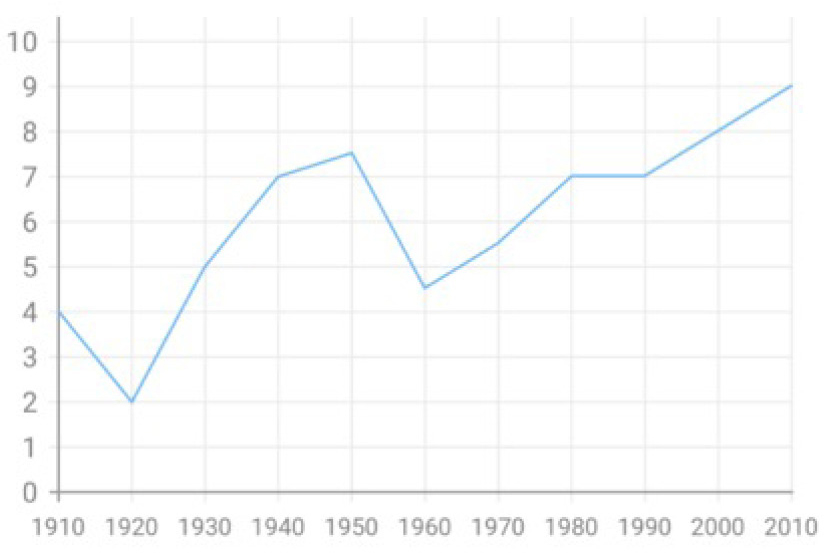
Line graph with insufficient contrast.
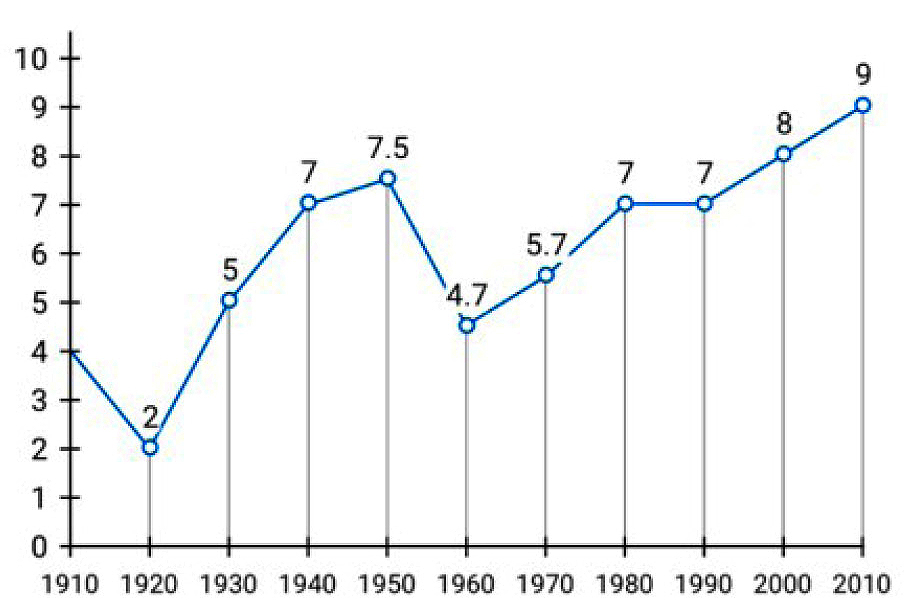
Line graph with sufficient contrast.
Other ways of modifying graphs are to thicken and darken lines with felt tip pens or highlight them with colored highlighters. Bold line paper is also available for purchase in multiple formats. To darken print on a page and increase contrast between the print and the background, an inexpensive strategy is placing a yellow acetate or filter overlay on the page, the use of which is said to reduce visual stress (Singleton and Henderson 2007).
Assistive technology
Assistive technology is a term that describes the use of supports through equipment or services that allow students with disabilities more independence in completing tasks (Zabala 2005). Assistive technology can be referred to as low-tech or high-tech. Low-tech supports include simple devices such as a desktop magnifier. These devices are easier to acquire and require very little training to use. High-tech supports include using a device that requires rechargeable batteries or computer software. The use of high-tech devices takes more training and interaction between the teacher and the student; however, over time these devices can provide more independence than low-tech devices (Van der Meer et al. 2012).
One form of assistive technology to aid the visually impaired or blind in reading is the screen reader. Screen readers render text and graphical images as either speech or tactile or both. For translating digital text to speech, the student might go to Google Docs and open a document, then go to the tools menu and select “accessibility settings,” then select “turn on screen reader support.” Some screen reading software is free and available online such as NonVisual Desktop Access (NVDA) for Microsoft Windows operating systems, which reads by voice any selection of text the cursor hovers over, or VoiceOver for MacOS that includes options for magnification, audio, and keyboard control.
Another form of assistive technology is the typoscope (see Figure 4), a reading device that consists of a rectangular black piece of cardboard with a smaller rectangular window cut into its center. The student places the device on a selection of text to reduce glare (Gissera 2022). For students who need to increase type size for reading, magnifying glasses and enlarged print have proven effective. Also, the American Printing House for the Blind (APH) has produced an interactive periodic table study set that includes tactile and brightly colored element symbols. Another item they offer is the Life Science Tactile Graphics book, which contains many important illustrations often encountered in biology classes such as the structure of plant and animal cells, skeletons, bacterial types, mitosis, meiosis, life cycles, food webs and chains, and more. Along with the tactile periodic table, there are also websites that produce interactive periodic tables that can be accessible using a touch screen.
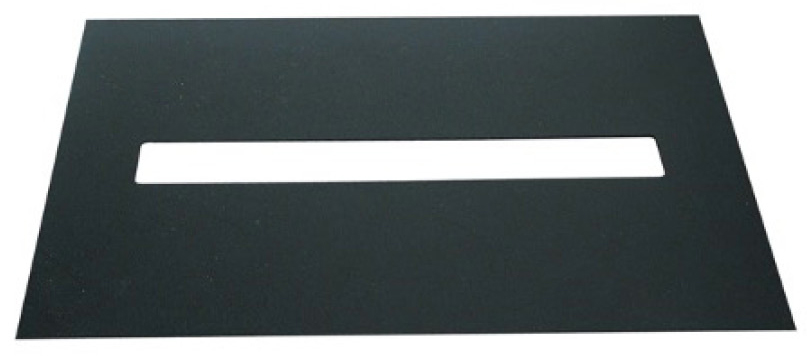
Typoscope.
Finally, for helping VI students take notes during class, there are software apps that can be useful such as the free Microsoft OneNote app that allows users to create interactive notebooks consisting of text, videos, files, and images or Notability, an app for iPad that allows users to draw on and annotate documents and photos.
Modifying pedagogy
For the science teacher who has a BVI student in her class, there are multiple ways she can modify her teaching to make it multi-sensory to better accommodate her student. When describing a demonstration or an image, the teacher must provide detailed verbal explanations, well beyond what she might provide sighted students and be prepared to offer comparisons familiar to students. For example, comparing the size of the human heart to that of a closed fist, or comparing the size of a human kidney to that of a computer mouse. When describing complex graphical, diagrammatic, or tabular information, it may be helpful to learn more about recommended guidelines for effectively describing this information such as those found on the National Center for Accessible Media website (GHS 2022), which provides examples of ways to present such information taken from bar charts, line graphs, Venn diagrams, scatter plots, tables, pie charts, and flow charts.
When content explanations for sighted students are enhanced with diagrams, it is important that the teacher consider providing a tactile version of the diagram for the BVI student. Commercially prepared braille Venn diagrams are available, or the teacher can make her own by using puff paint or a glue gun.
For highly visual science subjects such as biology, opportunities for BVI students should involve interaction with the real object if at all possible, followed by the transfer of their understanding of the actual object to a model or raised-line diagram. Three-dimensional models have proven to be useful to BVI students as well as sighted students. These models can be very expensive, but costs can be offset by creating the models with a 3D printer. Figure 5 provides an example of two models of chromosomes, the first made of pipe cleaners and a bead and the second created with a 3D printer, both useful for tactile purposes, although the pipe-cleaner model is in greater tactile detail. Other models typically used for sighted students can be tactilely modified for BVI students. For example, molecular ball and stick model sets usually contain “atoms centers” (balls) that are the same size but are different in color for different atoms. These can be tactilely marked by adding felt pads to the red pieces, cork bumpers to white pieces, and vinyl bumpers to black pieces, so that BVI students can differentiate among them. A tactile key should be created and given to the student along with the kit.
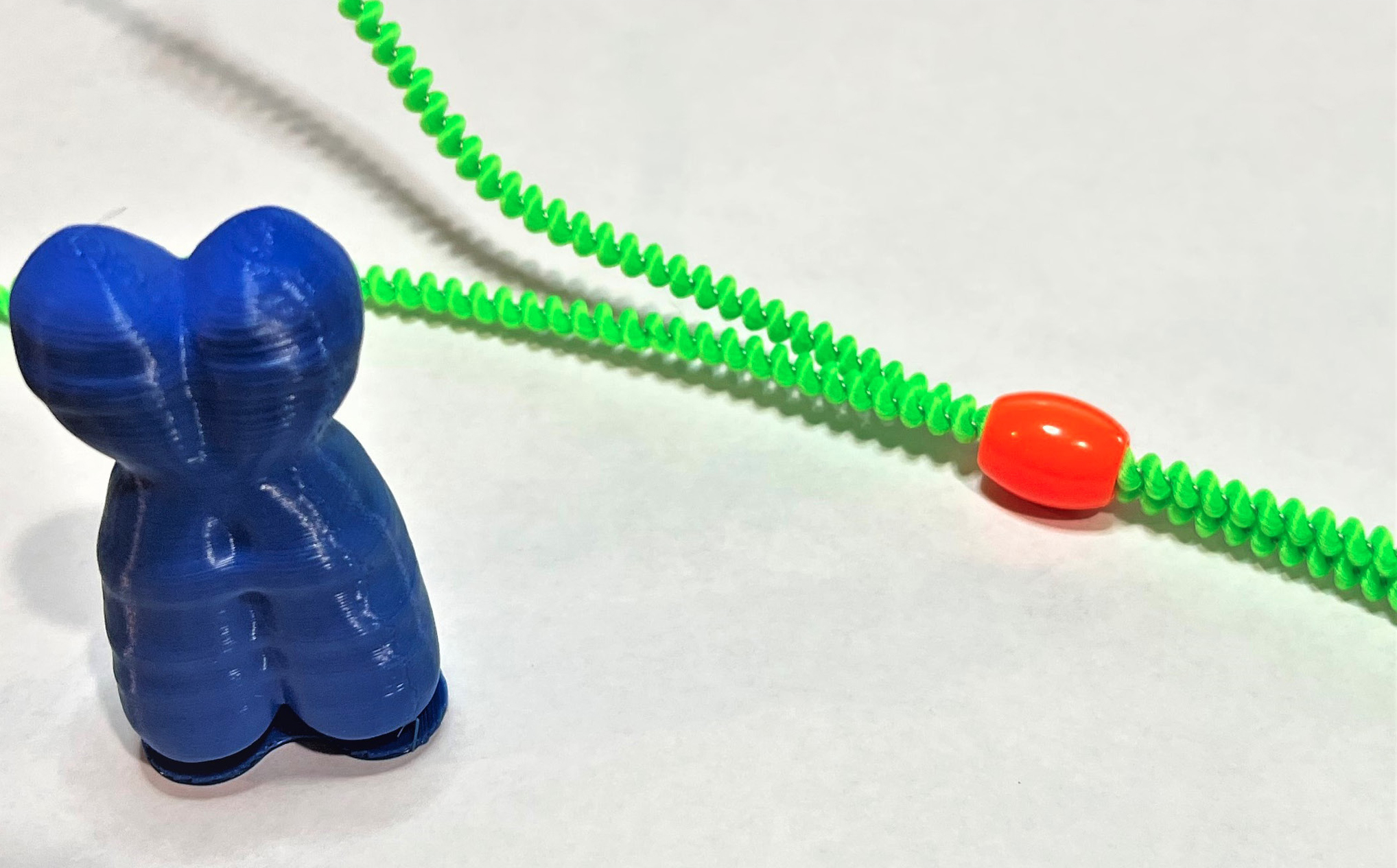
Chromosome models.
Any handouts given to sighted students should be provided to BVI students in braille, larger print, digital, tactile, or audio formats if possible. For lab procedures, it can be helpful to include body orientation language (straight, left, and right).
Hands-on inquiry investigations should be provided for all students but are particularly critical for the success of BVI students in science classes as they provide another means of understanding a science concept. When multiple items are required for the investigation, all of the items should be available on a tray on the lab table, so that everything needed is in one place and reachable. BVI students may also be assisted via the provision of extra time to complete assignments and through the provision of a verbal explanation of written material on the board; in the case of visual representation assignments, the BVI student is allowed to provide a written description rather than a drawing.
For an example of a complete 5E lesson plan modified for BVI students on chromosomes and karyotyping (see Figure 6; see Online Connections). This is a two-part, two-day 50- to 60-minute lesson (each day) designed for high school biology with an estimated cost of $10 or less for pipe cleaners and beads.
Modifying science equipment
To ensure that BVI students have a full experience in the science lab setting, we recommend a number of accommodations of science tools and equipment.
Measuring devices
For length measurements, metersticks and rulers can be modified for tactile use by stapling on each centimeter or millimeter marking so that users can feel measurement markings. In addition, premodified rulers, metersticks, and tape measures are available that have braille and raised-line markings (see Figure 7). For liquid measurements, several modifications can accommodate VI science students. For example, a graduated cylinder can be modified by placing a Wikki Stix tactile marker on the exterior of the graduated cylinder at the desired level. Alternately, inexpensive level indicator devices can be hung on the rim of a beaker to provide an auditory alarm when the beaker is almost full. For mass measurements, digital scales with audio readouts are available.
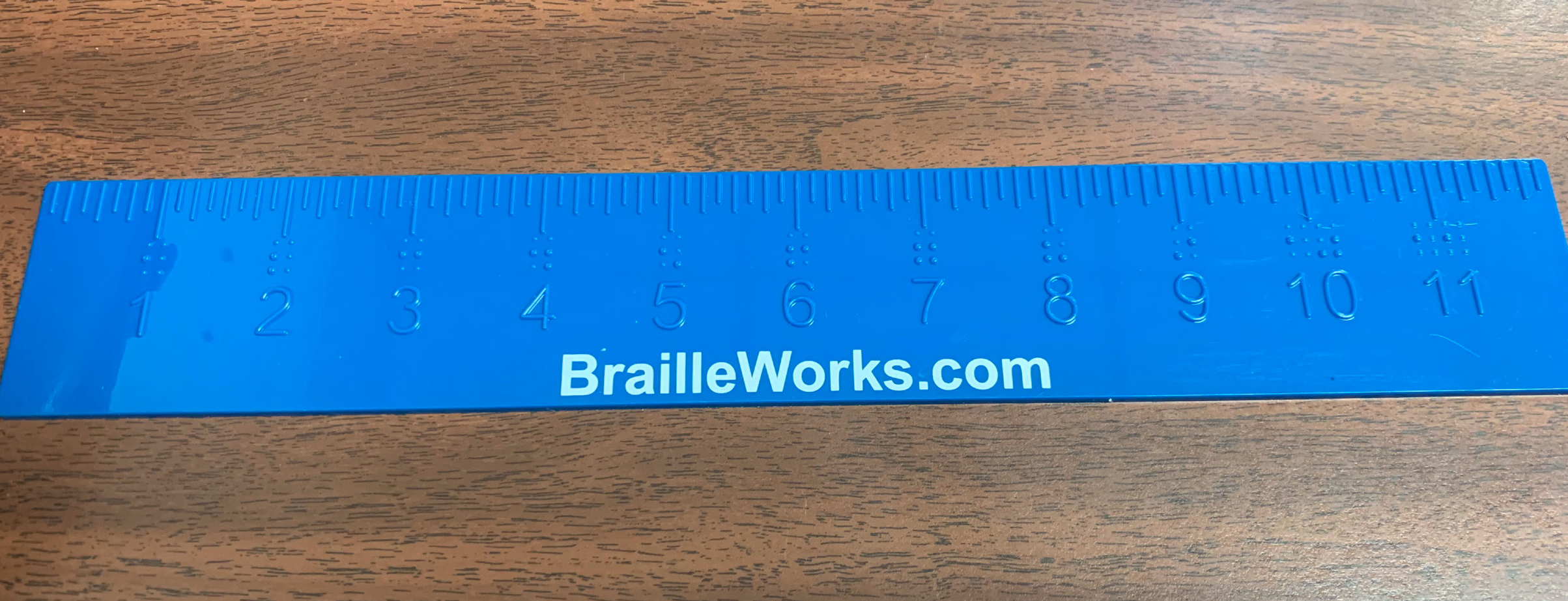
Tactile ruler.
Glassware
Use plastic instead of glassware, when possible. If glassware must be used, it should be stabilized by placing it in clamps or stands. To help VI students see liquid in a beaker, test tube, or flask, a sheet of black paper can be placed behind the glassware.
Tools with auditory readings
The entire experimental process can be modified using Sci-Voice Talking LabQuest, which can be connected to temperature probes, pH sensors, light and gas pressure sensors for auditory readings, allowing BVI students to collect their own data without help from a lab partner or instructor. Adapted time-keeping devices and weighing equipment are available that provide larger print, tactile markings, and voice output.
Safety
All safety equipment locations should be shown to all students and should be marked with tactile or braille labels for the BVI student. The locations of the equipment must not change during the tenure of the BVI student in the lab. General education students should be consistently reminded of this. BVI students should be provided cut-resistant gloves when handling lab glassware.
Modifying lab activities
Because most sciences are highly visual, careful consideration must be given to each lab activity so that BVI students can participate as much as possible without visual observations. This may seem difficult or even impossible, but many adaptations to activities can be made that will ensure BVI students are engaged. For example, a common lab in biology is the natural selection lab that relies on students’ visual identification of variation (e.g., colors of peppered moths). The same learning outcomes tied to this activity can be realized by BVI students if the focus moves from visual to textual observations (smooth paper versus sandpaper) (Caldwell and Teagarden 2006).
For meiosis and mitosis, both sighted and BVI students can create macaroni and yarn models of the various stages on paper plates, which will later serve as a three-dimensional study guide.
Alternative assessments
BVI students are often in need of modified assessments. Such changes can be made without compromising the integrity of the assessment and can include additional time for completion; breaking assignments into smaller, more manageable parts; reading the exam aloud to the student; translating the assessment into braille; enlarging the print size; providing audio formats; providing tactile graphs and diagrams; and modifying the exam structure (providing wider line spacing, more spacing between words, using bolded text, simplifying directions, and using high contrast). For science lab assessments, practical examinations can be administered with tactile models (e.g., three-dimensional cells), tactile equipment (e.g., rulers with raised markings), and talking equipment (e.g., digital thermometers with voice readings).
Using accessibility-based science assessments for BVI students is another more innovative methodology for evaluation (Hansen et al. 2016). Haptics (technology involving the sense of touch) is one such example. Vibrotactile haptics as used with Android tablets involves the use of vibration as sensed through touch that can allow BVI students to “visualize” lines and other geometrical shapes (Hakkin et al. 2013). Hansen et al. (2016) has had success using these methods for assessing the scientific knowledge of BVI students regarding the investigation of evaporation.
Conclusion
Students with VIs can be just as successful in science courses as sighted students and can seek and attain science degrees and careers with great success. BVI scientists’ difficulties in visualization have led to unique perspectives and discoveries that sighted scientists might never have considered. For example, Mona Minkara, blind since childhood, holds a PhD in computational chemistry. In her graduate work surrounding proteins, she was led to mathematically plot their dynamics since she was unable to see videos, revealing patterns unseen by sighted peers. Amy Bower is a visually impaired research oceanographer who examines ocean currents, often studying from the decks of Oceanus, a research vessel at Woods Hole. She makes use of various devices such as magnifying bifocals with embedded telescopic lenses and electronic note takers. Finally, Henry Wedler, a computational organic chemist and CEO of Accessible Science created “Chemistry Camp” for BVI high school students who enjoy and would like to further explore chemistry via active learning.
As high school science teachers, we are often situated at the inception of students’ degree choices and career decisions. For BVI students, our involvement in making science accessible to them in a positive and encouraging manner can mean the difference between pursuing a science degree and career or not. Further, as technology integration continues to progress, more BVI students will have access to science curricula through the use of innovative methods.
Online Connections
Figure 6 Chromosomes and Karyotypes 5E lesson BVI: https://bit.ly/3ybw0s0
Karyotype layout worksheet: https://bit.ly/3SQail1
Connecting to the Next Generation Science Standards: https://bit.ly/3rwIeYc
Sandy Watson (skwatson1209@gmail.com) is an associate professor of curriculum and instruction and Jeremy Bell is an assistant professor of special education, both at The University of Louisiana Monroe, Monroe, LA.
Disabilities Inclusion Multilingual Learners Teacher Preparation Teaching Strategies



